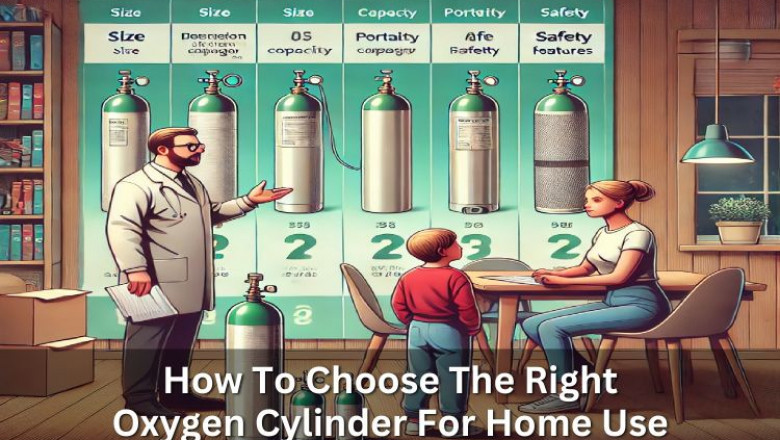views
How To Choose The Right Oxygen Cylinder For Home Use
Oxygen therapy is essential for patients with respiratory conditions such as COPD, asthma, pneumonia, and post-COVID recovery. Having the right oxygen cylinder at home ensures that patients receive an adequate and uninterrupted oxygen supply, improving their overall health and quality of life. However, choosing the right one can be confusing with so many options available. This guide will help you understand how to select the best oxygen cylinder for home use.
1. Understand the Patient’s Oxygen Requirement
Before purchasing or renting an oxygen cylinder, consult a doctor or respiratory therapist to determine:
- The oxygen flow rate (liters per minute - LPM) required.
- Whether the patient needs continuous flow or pulse-dose delivery.
- The duration of oxygen use per day.
This will help you choose a cylinder with the appropriate size and capacity.
2. Choose the Right Cylinder Size
Oxygen cylinders come in various sizes based on capacity and portability:
- Small (B-type or D-type cylinders) – Suitable for short-term or emergency use.
- Medium (E-type cylinders) – Can be used with a trolley for easy movement within the home.
- Large (M-type or H-type cylinders) – Ideal for long-term oxygen therapy but less portable.
If the patient needs oxygen only during emergencies, a smaller, portable cylinder is ideal. For continuous therapy, a larger cylinder is more practical.
3. Consider Cylinder Material and Weight
Steel or aluminum are used to make oxygen cylinders:
- Steel cylinders – Heavier but durable and cost-effective.
- Aluminum cylinders – Lightweight and portable, ideal for elderly patients or those who need mobility.
If mobility is a concern, opt for lightweight aluminum cylinders for ease of handling.
4. Check for Cylinder Capacity and Oxygen Duration
Different cylinders hold different amounts of oxygen. The capacity of the cylinder determines how long it lasts before needing a refill. Factors affecting oxygen duration include:
- Flow rate prescribed by the doctor.
- Size of the cylinder.
- Type of regulator used (continuous or pulse dose).
A high-flow rate will deplete oxygen faster, so choosing a larger-capacity cylinder may be beneficial.
5. Understand the Refilling and Replacement Process
Before getting an oxygen cylinder, check:
- Where and how to refill it.
- Cost and frequency of refilling.
- Availability of refilling services nearby.
- Alternative backup options in case of emergencies.
Some suppliers also offer cylinder exchange programs, allowing you to swap an empty cylinder for a filled one quickly.
6. Look for Safety Features
Safety is crucial when handling medical oxygen at home. Ensure your oxygen cylinder has:
- A pressure gauge to monitor oxygen levels.
- A proper regulator and flow meter to control oxygen delivery.
- Safety valves to prevent leaks or excessive pressure buildup.
Additionally, follow fire safety guidelines, as oxygen supports combustion.
7. Consider Renting vs. Buying
For short-term oxygen therapy, renting a cylinder is a cost-effective option. If long-term use is required, purchasing a cylinder may be more economical in the long run. Renting benefits include:
- Lower upfront costs.
- Regular maintenance and refilling services.
- Flexibility to upgrade or change cylinder size.
Check with local medical suppliers for the best rental or purchase options.
8. Compare Prices and Supplier Services
When selecting an oxygen cylinder supplier, compare:
- Pricing for purchase and refills.
- Availability of 24/7 emergency services.
- Home delivery and installation options.
- Customer reviews and reliability.
A trusted supplier ensures a hassle-free experience with timely refills and support.
Final Thoughts
Choosing the right oxygen cylinder for home use involves understanding the patient’s needs, selecting the appropriate size and material, ensuring safety, and checking refilling options. Whether you buy or rent, make sure you opt for a trusted supplier with excellent service and maintenance support.
Having the right oxygen supply at home ensures better health, improved comfort, and peace of mind for both the patient and their family. Take your time, consult professionals, and make an informed choice!














Comments
0 comment